Florida's Reptiles and Amphibians
American Alligator, American Crocodile, Spectacled Caiman, Gopher Tortoise, Florida Box Turtle, Florida Cooter, Florida Redbelly Turtle, Red-eared Slider, Florida Soft-shelled Turtle
American Alligator - Alligator mississippiensis
Native
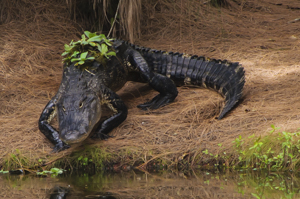
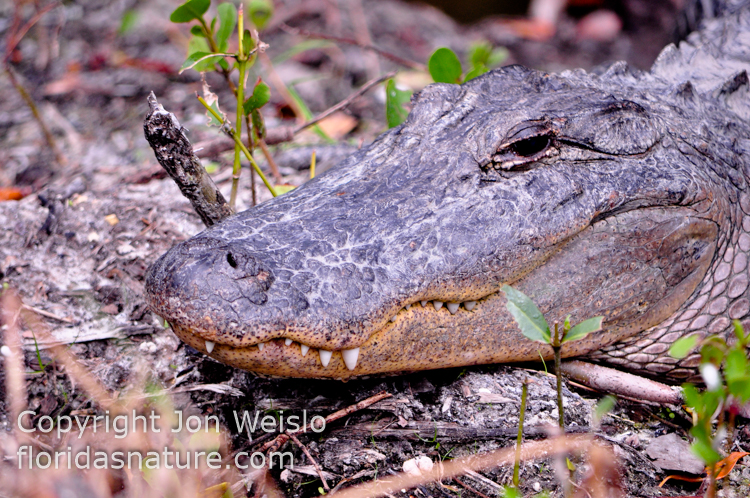
Male alligators grow to 19 feet long and weigh over 1,000 pounds while females usually top out at about 9 feet and half the weight of males.
Alligators live in and around freshwater swamps, marshes, rivers, and lakes and can often be seen sunbathing on the banks of waterways. Occasionally alligators will wander into the brackish water of estuaries but generally don't stay long as they are not equipped with salt excreting glands like crocodiles are.
Alligators are carnivorous ambush predators, they will lie in wait for an unsuspecting animal, bird or turtle to get within range and lunge explosively on their prey, grabbing it in powerful jaws and swallowing it whole, or if the prey is too large to swallow whole the alligator will shake its head side to side or roll its body violently until it tears off a more managable piece, this is often called the "death roll". Alligators are capable of biting down with a force exceeding 2000 p.s.i., but cannot really "chew" their food.
Baby alligators eat a wide variety of insects, crayfish, small fish, lizards and frogs. Adults will eat any and all types of prey that comes within range; fish, turtles, mammals, birds, reptiles and even smaller alligators and carrion.
Florida wildlife is great to photograph or simply enjoy watching, however if not respected or if someone is simply ignorant of the injury wild animals are capable of can result in severe injury or death. Probably the most dangerous simply because of their large population and size is the alligator, every so often there are instances of someone or their pet being attacked, usually with tragic results.
Alligators are apex predators, they hunt their prey in stealth mode and can hold their breath and lie motionless underwater for about an hour, they may be present in ANY freshwater pond, creek, stream, canal, swamp or river in Florida. Feeding or harassing alligators is illegal, studies have shown that alligators involved in attacks on humans are usually ones that have been fed. Feeding alligators can result in 6 month in jail and a $500.00 fine and possibly your kids, dogs or neighbors death.
If you know of a problem alligator or observe someone feeding an alligator you can report it to the FWC Nuisance Alligator Hotline at 1-866-FWC-GATOR (1-866-392-4286).
American Crocodile - Crocodylus acutus
Native
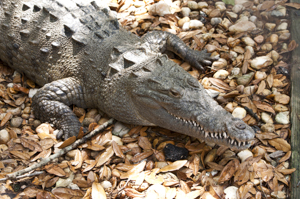

The American crocodiles historical range reached its northern limits around Martin county on the Atlantic coast and Charlotte county on the Gulf coast.
Despite the Crocodiles fearsome reputation and prehistoric appearance, the American crocodile is rarely seen and is shy by nature, there are an estimated 400-500 within Florida. South Florida is the only place on earth where alligators and crocodiles co-exsist.
Threatened by habitat loss, this animal is listed as an endangered species and is protected by state and federal law. Males grow to about 15 feet, females 8 to 12 feet. The American crocodile is olive brown to tan in color with a much longer, narrower snout than the Alligator and an exposed forth tooth on the lower jaw.
Crocodiles will eat just about anything, feeding on fish, turtles, water birds and any unaware mammal that strays too close including deer and feral pigs. The American crocodile is found primarily in the brackish waters near the mouths of rivers and in the mangrove swamps of extreme South Florida.
Spectacled Caiman - Caiman crocodilus
Non-Native
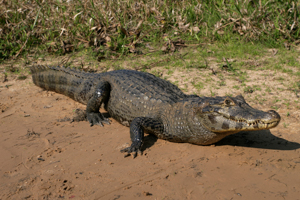
The Spectacled Caimen originally imported for the pet trades has established breeding populations in Dade and Broward counties in South Florida. Native range is from southern Mexico to northern Argentina where it grows to lengths over 8 feet, it is slightly smaller in Florida with 6 feet being considered the maximum length.
Found in freshwater ponds, creeks, marshes and rivers this crocodilian transplant competes with the native American Alligator for food and suitable habitat. Dark brown to olive color, has a more triangular shaped head than an alligator with a ridge across the snout just in front of the eyes.
Gopher Tortoise - Gopherus polyphemus
Native
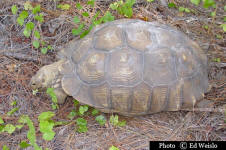
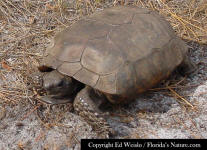
Above - Adult Gopher tortise
Below - Juvenile Gopher tortise
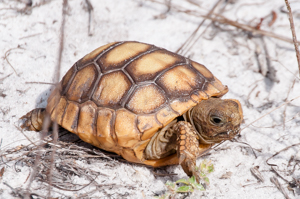
Protected by federal and state law - Killing or wounding gopher tortoises is a third degree felony and punishable by up to five years in prison, a $5,000 fine or both, it is also illegal to disturb a gopher tortise burrow.
Gopher Tortoises live in open, sunny areas where the plants they feed on are able to grow, this includes scrub, dry pineland, and dry prairie habitat on well drained sandy soils. The fruit of the gopher apple, saw palmetto berries, blackberries, along with grasses, sedges and other herbaceous plants make up the bulk of their diet.
Sometimes referred to as a gopher turtle, the gopher tortoise averages 9 to 11 inches long and may be up to 15 inches long, with a lifespan that can exceed 50 years, young tortise or hatchlings are yellowish orange color, adults are a dull grey or varying shade of dull brown. Known as a "keystone species" over 350 other animals rely on the burrows of the tortoise as a necessary part of their habitat, including the threatened Eastern Indigo Snake (Drymarchon corais couperi) and Burrowing Owl (Athene cunicularia).
Skunk, fox, mice, frogs and other small invertebrates are frequent visitors to the tortoise burrows, that may be up to 40 feet long and 10 feet deep, these often become the only avenue of escape from a wildfire for many smaller animals, a tortise may dig several burrows during its lifetime. A good indication of the size of the tortise that dug it, as the width of the burrow is equal to the length of the tortoise thus allowing them to turn around at any point in the burrow.
The entrance of a gopher tortoise's burrow is characterized by a low mound of excavated sand, called the apron - this is also where the female buries her eggs so please don't walk or stand on it.
The biggest current threats to the Gopher Tortoise are loss of habitat, upper respiratory infections and poaching.
Florida Box Turtle - Terrapene carolina bauri
Native
_small.jpg)
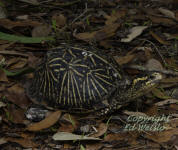
The Florida Box turtle is one of four sub-species of Eastern box turtle present in Florida, its range is limited to the Florida peninsula. Box turtle populations in Florida are on the decline because of loss of habitat and over collecting for the pet trade.
The Florida box turtle has a high domed, rounded, dark brown and black carapace 4 3/10 inches long with yellow stripes in a somewhat fan shaped pattern. These turtles are so named for their ability to almost completely close the shell because of its hinged plastron. Box Turtles are omnivorous, their diet includes a variety of plants, fruit, berries, insects, eggs, worms and mushrooms.
The Florida box turtle has a lifespan of at least 50 years in the wild and may be found in a varity of habitat types prefering mature forest habitat with a home range of about one square mile.
Florida Cooter - Pseudemys floridana
Native
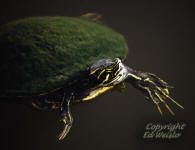
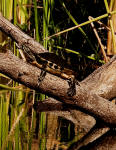
One of the most common turtles in Florida, the Florida Cooter is often seen sunning itself on the banks of freshwater creeks, ponds or slow moving rivers.
Growing to 15 inches in length this turtle is a herbivore, although juveniles will eat the occasional insect.
Florida Cooters construct a three part nest on land, digging one deep hole with two shallower holes to the sides of it. The female lays most of her eggs in the deeper hole, putting one or two eggs in the shallow holes in an attempt to distract predators from the main egg cache.
Florida Redbelly Cooter - Pseudemys nelsoni
Native
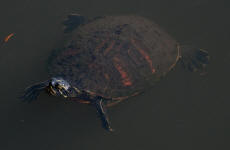
Common names include - Florida Red-bellied Cooter, Florida Red-bellied turtle.
The Florida Redbelly turtle has an unusual method of protecting its eggs, it often lays them in an Alligators nest! While this behavior has it risks, it provides a warm nest that the female 'gator will defend from predators.
Length to 13 inches, average is about 10 inches. Shell is round and domed, highest at mid-point. Upper shell is dark with reddish bars, lower shell red tinged when young, older turtles often loses the red belly color. Single yellow line on top of head. This turtle is omnivorous but feeds mainly on aquatic vegetation.
Habitat - Prefers freshwater, occasionally found in brackish water. Ponds, creeks, marshes, swamps, slow moving rivers, always with abundant vegetation.
Red-eared Slider - Trachemys scripta elegans
Non-native
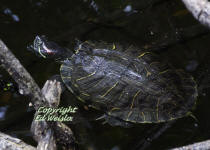
The Red-eared slider is one of the most widely introduced species of turtle worldwide. In Florida, as with other non-native species, this turtle competes with native species for food and habitat. Identified by its unique red or orange stripe on the head, behind each eye. Adults grow to about 12 inches, males have elongated front claws. The Red-eared slider can be found in freshwater lakes, ponds and deepwater Marshes.
Florida Soft-shell Turtle - Apalone ferox
Native
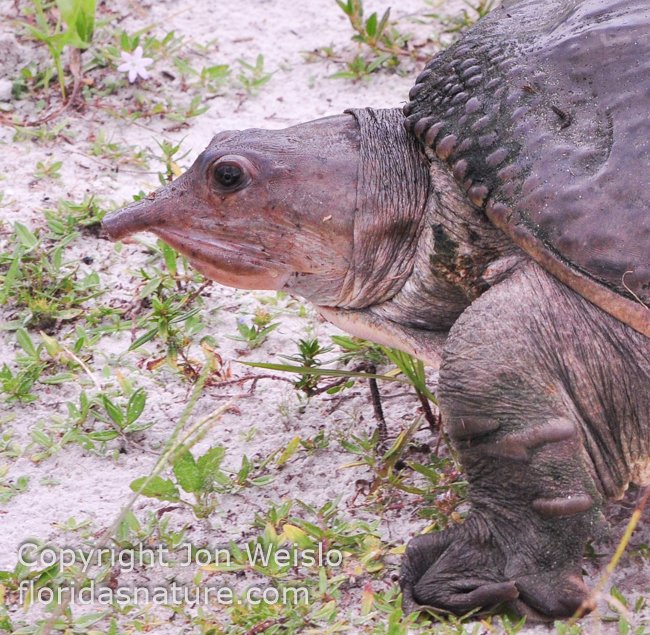
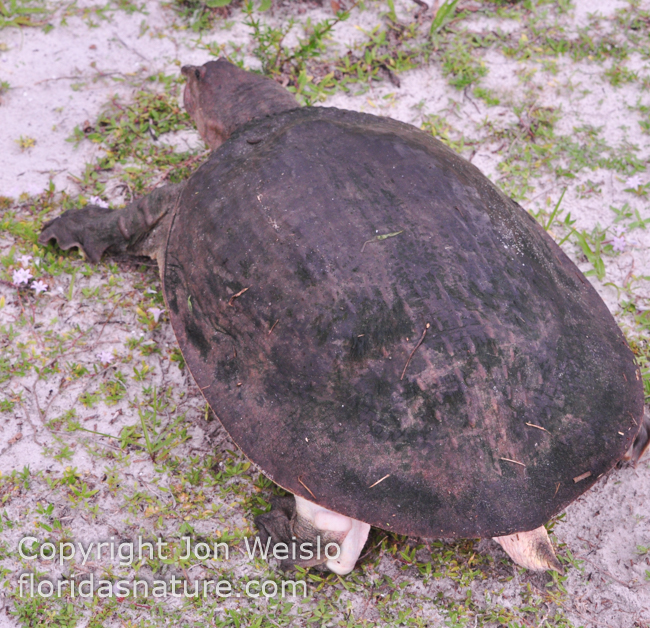
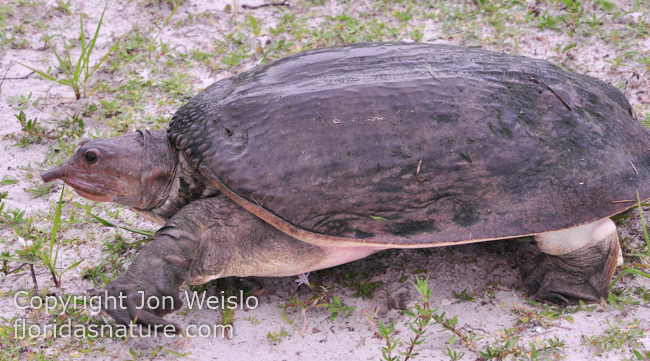
Soft-shell turtles spend their time hiding in the sand or mud waiting to ambush fish, snails and crayfish or floating beneath the waters surface.
The Florida soft-shell turtle can be found throughout Florida and into Georgia, Alabama and as far north as southern South Carolina.
This unusual turtle has leathery skin growing over a hard shell, a very long neck and an unpredictable demeanor, these turtles are surprisingly fast, and are capable of delivering a nasty bite. Their neck is also long enough to reach almost to the back of their shell when stretched out.
Juvenile Florida soft-shell turtles are olive yellow with gray spots, adults typically have blotchy skin and brownish green to tan shells. Females grow over two feet in length, males are somewhat smaller, usually 12-14inches long.